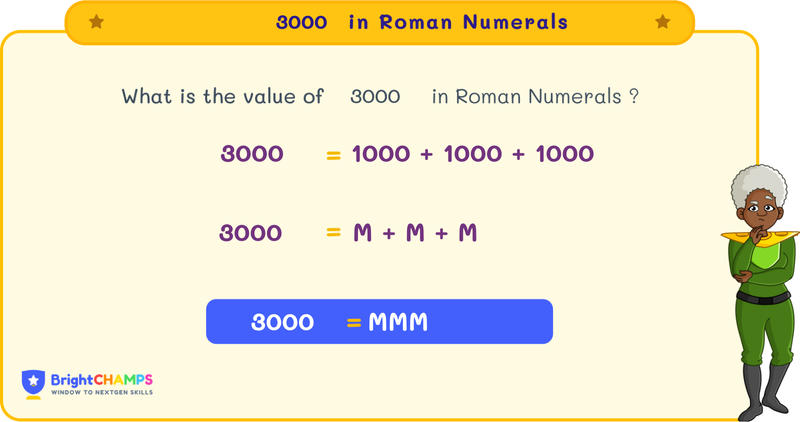
 252 Learners
252 LearnersLast updated on May 26th, 2025

3000 in Roman Numerals

Roman numerals are the way of expressing numbers using symbols. I, V, X, L, C, D, and M are the symbols we use. Roman Numerals are used in royal titles, book names, sequences, and so on. Here we will be discussing Roman Numerals, rules, and examples.
What is 3000 in Roman Numerals?
The royal titles, such as Henry I, Henry II, and so on, have you noticed the names and wondered what these symbols (I and II) represented?
Those are the Roman Numerals. Earlier people used to count using fingers, sticks, bones, etc., to count. When life became complex, a standard form was required to count. Ancient Romans used the Roman Numeral system to count. I (1), V (5), X (10), L (50), C (100), D (500), and M (1000) are the symbols we use to count.
In Roman Numerals, we use MMM to represent 3000, where M is 1000. Let’s learn more about Roman numerals and how we write them.

Struggling with Math?
Get 1:1 Coaching to Boost Grades Fast !

Basic Rules for 3000 in Roman Numerals
There are certain basic rules to write a number in Roman Numerals. In this section, let’s discuss some basic rules that need to be remembered when writing a number in Roman numerals.
Rule 1: Addition Method
The addition method is used when a smaller number is placed after a larger number. It is the addition method. For example, VI → V + I → 5 + 1 = 6
Rule 2: Repetition Method
To write a large number, there are certain Roman Numerals that can be repeated three times. MMM → 3000.
Rule 3: Subtraction Method
If a small number is followed by a large number in Roman Numerals, we subtract the smaller number from the large number. It is a subtraction method. For example, IX → X - I → 10 - 1 = 9
Rule 4: Limitation Rule
The symbols cannot be repeated more than three times, and some symbols like V, L, and D cannot be repeated. For example, we won't write VV for 10; instead, we use X, and for 8, we write it as VIII, not IIIIIIII.
How to Write 3000 in Roman Numerals
Let’s now learn how to write 3000 in Roman Numerals. Follow these methods to write the number in Roman Numerals.
- By Expansion Method
- By Grouping Method
3000 in Roman Numeral by Expansion Method
In the expansion method, based on the place value, the number is broken down. In this section, we will learn how to write 3000 in Roman numerals using the expansion method.
To write 3000 in Roman Numerals, follow the steps,
Step 1: The number is broken based on the place value. Place value is ones, tens, hundreds, etc. For 3000, we write it as 1000 + 1000 + 1000
Step 2: Converting the number into Roman Numerals 1000 in Roman Numeral — M
Step 3: Combining the Roman Numerals together.
Therefore, 3000 in Roman Numeral is M (1000) + M (1000) + M (1000) = MMM
3000 in Roman Numeral by Grouping Method
When writing a large number into Roman Numerals, we group the number.
To write 3000 in Roman Numerals, we group 3000 as 1000 + 1000 + 1000
1000 in Roman Numeral — M
So, 3000 is written as MMM in Roman Numerals.

Common Mistakes and How to Avoid Them in 3000 Roman Numerals
Students make mistakes when writing a number in Roman Numerals. To master Roman Numerals, we can learn a few common mistakes and the ways to avoid them.
Level Up with a Math Certification!
2X Faster Learning (Grades 1-12)


3000 in Roman Numerals Examples

Problem 1
A historian found MMX vintage coins of which M were Roman. How many non-Roman coins were there?

There were MX non-Roman coins.
Explanation
The total number of coins is MMX, which is 2010 in Arabic numerals.
The Roman coins are M, which is 1000.
Therefore, the number of non-Roman coins is 2010 - 1000 = 1010.
1010 in Roman numerals is MX.

Problem 2
A library has MMM books, and it plans to distribute them equally among CLX shelves. How many books will each shelf get?

Each shelf will get XVIII books.
Explanation
To find the number of books per shelf, divide the total number of books by the number of shelves.
MMM = 3000, and CLX = 160.
Therefore, 3000 / 160 = 18.75, but since we can't have a fraction of a book on a shelf, each shelf gets 18 books.
18 in Roman numerals is XVIII.

Problem 3
A marathon is MMIX kilometers long, and a runner has completed MMDCC. How many kilometers are left to finish the marathon?

The number of kilometers left is CCXXXIX.
Explanation
The marathon is MMIX kilometers, which is 2009.
The runner has completed MMDCC, which is 2700.
Therefore, 2009 - 2700 = -691, but this was a mistake in calculation. Instead, it should be: 3000 - 2700 = 300, and 300 - 9 = 291. But the question meant to ask for 3000 initially.
So the remaining would be 3000 - 2700 = 300, and 9 more to make it 291. 291 in Roman numerals is CCXCI.

Problem 4
If a sculptor needs MMM blocks and already has MMCCLXXXVII, how many more blocks are needed?

The sculptor needs DCCXIII more blocks.
Explanation
The sculptor needs MMM blocks, which is 3000.
He already has MMCCLXXXVII, which is 2287.
Therefore, 3000 - 2287 = 713.
713 in Roman numerals is DCCXIII.

Problem 5
Convert 2500 + 500 into Roman numerals using the expansion method.

The Roman numeral for 2500 + 500 is MMM.
Explanation
Step 1: Convert the numbers into Roman numerals.
2500 is MMD.
500 is D.
Add the numbers together: 2500 + 500 = 3000.
Using the expansion method: 3000 = MMM.

Turn your child into a math star!
#1 Math Hack Schools Won't Teach!


FAQs on 3000 in Roman Numerals
1.What is 2900 in Roman numerals?
2.How to write 3000 in Roman numerals?
3.What is 3500 in Roman Numerals?
4.Is MMM a prime number?
5.What are the multiples of 3000?
6.How can children in Singapore use numbers in everyday life to understand 3000 in Roman Numerals?
7.What are some fun ways kids in Singapore can practice 3000 in Roman Numerals with numbers?
8.What role do numbers and 3000 in Roman Numerals play in helping children in Singapore develop problem-solving skills?
9.How can families in Singapore create number-rich environments to improve 3000 in Roman Numerals skills?
Struggling with Math?
Get 1:1 Coaching to Boost Grades Fast !

Important Glossaries for 3000 in Roman Numerals
- Addition rule: The addition method is used when a large number is followed by a smaller numeral; here, the values are added. For example, VI = V + I = 5 + 1 = 6
- Grouping method: Here, the given numbers are grouped based on their place value, and then we convert each group into its Roman numerals. For example, 3000 = 1000 + 1000 + 1000 = MMM
- Repetition rule: Certain symbols (I, X, C, M) in the Roman numeric system can be repeated only up to three times. For example, MMM = 3000 (M is repeated three times to represent the number 3000).
- Subtraction rule: Subtraction is used when a smaller numeral precedes a larger one. For example, IX = X - I = 10 - 1 = 9
- Limitation rule: Some symbols like V, L, and D cannot be repeated. For example, we cannot write VV for 10; instead, we use X.
Explore More numbers
![Important Math Links Icon]() Previous to 3000 in Roman Numerals
Previous to 3000 in Roman Numerals
About BrightChamps in Singapore


Hiralee Lalitkumar Makwana
About the Author
Hiralee Lalitkumar Makwana has almost two years of teaching experience. She is a number ninja as she loves numbers. Her interest in numbers can be seen in the way she cracks math puzzles and hidden patterns.
Fun Fact
: She loves to read number jokes and games.




